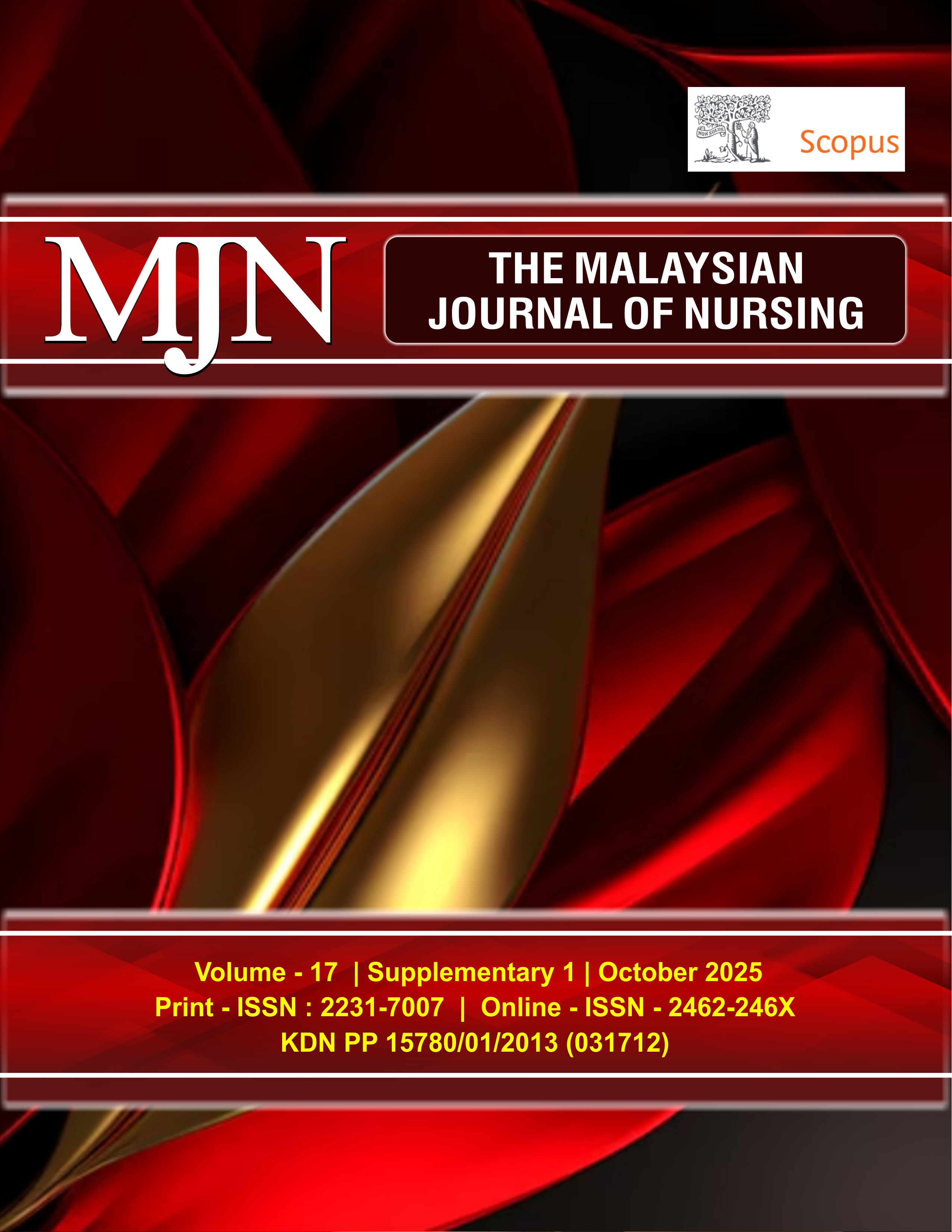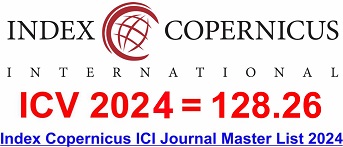Evaluation of Attitudes of Antenatal Care During Pregnancy at Primary Health Care Centers in Iraq: A Cross-Sectional Study
DOI:
https://doi.org/10.31674/mjn.2025.v17isupp1.007Abstract
Background: Primary Health Care (PHC) plays a critical role in ensuring that maternity care is accessible and effective for all mothers, reducing the risk of complications during childbirth. Antenatal Care (ANC) is a key component of this, as it helps detect and address potential health concerns throughout pregnancy, improving both maternal and neonatal outcomes. Methods: A descriptive cross-sectional study was carried out to assess the effectiveness of the ANC service in Nasiriyah, Iraq, focusing on its components, analysis, and results. The study involved 124 women receiving ANC services from three health care centres and two rural health centres in Nasiriyah, Iraq. Results: The results revealed that the average age of the women was 26.5 years, more than half were highly educated, (54.84%) were housewife, the percentage of women who attended the ANC once (16.93%), twice (39.52%), three times (30.64%), and four or more times (12.91%) during the duration of their pregnancy, regarding the overall content, the level of services provided by health canters and hospitals was satisfactory to (65.32%) pregnant women, the satisfaction level with Employees behaviour, (54.03%) of pregnant women felt satisfied, Regarding the waiting time, 69.35% of the individuals expressed satisfaction, (24.19%) expressed dissatisfaction, while 91.94% of individuals expressed satisfaction regarding fees. Conclusion: Most pregnant women have acceptable satisfaction with ANC services.
Keywords:
Antenatal Care (ANC), Challenge, Maternity, Maternal Healthcare (MHC), Socio-Demographic FactorsDownloads
References
Afaya, A., Azongo, T. B., Dzomeku, V. M., Afaya, R. A., Salia, S. M., Adatara, P., & Amogre Ayanore, M. (2020). Women’s knowledge and its associated factors regarding optimum utilization of antenatal care in rural Ghana: A cross-sectional study. PLOS One, 15(7). https://doi.org/10.1371/journal.pone.0234575
Akseer, N., Wright, J., Tasic, H., Everett, K., Scudder, E., Amsalu, R., & Bhutta, Z. A. (2020). Women, children and adolescents in conflict countries: An assessment of inequalities in intervention coverage and survival. BMJ Global Health, 5(1). https://doi.org/10.1136/bmjgh-2019-002214
Al-Abedi, G. A. (2021). Identification of pregnant women's satisfaction among antenatal health care services in primary health care centers at Al-Amara city/Iraq. Bahrain Medical Bulletin, 43(2), 492–493. https://doi.org/10.12816/0056789
Al-Agele, F. R., & Hassan, B. A. (2020). Gender preference among a sample of married women attending selected primary healthcare centers in Baghdad Governorate in 2019. Iraqi National Journal of Medicine, 2, 33–40. https://doi.org/10.47723/INJM.2020.2.1.4
Alfaaz, Z. B. H. (2025). Awareness of health matters related to pregnancy: A cross-sectional study among women attending primary health care centers in Basra. Iraqi National Journal of Medicine, 7(1). https://doi.org/10.37319/iqnjm.7.1.5
Alhaidari, T., Amso, N., Jawad, T. M., Alnakkash, U., Khazaal, F., Alnaaimi, A., & Al Hilfi, T. (2018). Feasibility and acceptability of text messaging to support antenatal healthcare in Iraqi pregnant women: A pilot study. Journal of Perinatal Medicine, 46(1), 67–74. https://doi.org/10.1515/jpm-2017-0123
Ali, M., Bhatti, M. A., & Kuroiwa, C. (2008). Challenges in access to and utilization of reproductive health care in Pakistan. Journal of Ayub Medical College, 20(4), 3–10. https://doi.org/10.1016/j.jamc.2008.09.001
Al-Kuran, O., Jaber, D. Z., Ahmad, A., Abdulfattah, S., Mansour, S., Abushqeer, R., & Al-Mehaisen, L. (2024). Understanding perspectives on neural tube defect management: Insights from Jordanian parents. The Journal of Maternal-Fetal & Neonatal Medicine, 37(1). https://doi.org/10.1080/14767058.2023.2334846
Ameh, C. A., Bishop, S., Kongnyuy, E., Grady, K., & Van den Broek, N. (2011). Challenges to the provision of emergency obstetric care in Iraq. Maternal and Child Health Journal, 15, 4–11. https://doi.org/10.1007/s10995-010-0563-8
Ansu-Mensah, M., Danquah, F. I., Bawontuo, V., Ansu-Mensah, P., & Kuupiel, D. (2020). Maternal perceptions of the quality of care in the Free Maternal Care Policy in sub-Sahara Africa: A systematic scoping review. BMC Health Services Research, 20, 1–11. https://doi.org/10.1186/s12913-020-05625-4
Anwar, I., Sami, M., Akhtar, N., Chowdhury, M. E., Salma, U., Rahman, M., & Koblinsky, M. (2008). Inequity in maternal healthcare services: Evidence from home-based skilled-birth-attendant programmes in Bangladesh. Bulletin of the World Health Organization, 86(4), 252–259. https://doi.org/10.2471/BLT.07.042754
Ata, B., Ata, A. S., Urman, B., & Ata, B. (2011). Evidence based approach to recurrent miscarriage. Turkish Journal of Obstetrics and Gynecology, 8(1), 5–20. https://doi.org/10.4274/tjod.2011.01
Ayele, B. A., Holliday, E., & Chojenta, C. (2025). Determinants of antenatal care service utilisation in sub-Saharan Africa: An analysis of demographic and health surveys data (2015–2022). Archives of Public Health, 83. https://doi.org/10.1186/s13690-025-01608-1
Boah, M., Abanga, E. A., & Adokiya, M. N. (2024). Quality of antenatal care services received by women of reproductive age prior to delivery in selected public health facilities in the northern zone of Ghana. BMC Health Services Research, 24. https://doi.org/10.1186/s12913-024-09876-5
Bountogo, M., Sié, A., Zakané, A., Compaoré, G., Ouédraogo, T., Lebas, E., & Oldenburg, C. E. (2021). Antenatal care attendance and risk of low birthweight in Burkina Faso: A cross-sectional study. BMC Pregnancy and Childbirth, 21, 1–8. https://doi.org/10.1186/s12884-021-03600-9
Creswell, J. W., & Creswell, J. D. (2017). Research design: Qualitative, quantitative, and mixed methods approaches. 4th edition, Sage publications.
Dada, A. (2019). Factors affecting maternal health seeking behaviour in a Yoruba community of Nigeria: An analysis of socio-cultural beliefs and practices [Doctoral dissertation, University of KwaZulu-Natal, Howard College]. https://doi.org/10.13140/RG.2.2.12345.67890
Fawole, A. O., Okunlola, M. A., & Adekunle, A. O. (2008). Clients’ perceptions of the quality of antenatal care. Journal of the National Medical Association, 100(9), 1052–1058. https://doi.org/10.1016/S0027-9684(15)31440-4
Garrod, T. (2022). Women’s lived experiences of maternity care in pregnancy after loss: A Heideggerian perspective [Doctoral dissertation, Bishop Grosseteste University]. https://doi.org/10.13140/RG.2.2.12345.67890
Haddrill, R., Jones, G. L., Mitchell, C. A., & Anumba, D. O. (2014). Understanding delayed access to antenatal care: A qualitative interview study. BMC Pregnancy and Childbirth, 14, 1–14. https://doi.org/10.1186/1471-2393-14-207
Harding, S., & Libal, K. (2019). War and the public health disaster in Iraq. War and Health: The Medical Consequences of the Wars in Iraq and Afghanistan, 4(111), 128–136. https://doi.org/10.1017/CBO9780511811234.012
Jaber, D. L., & Sahib, A. A. (2025). Evaluation of antenatal care facilities and services in primary healthcare centers in Baghdad/Iraq. World Journal of Advance Healthcare Research, 9(4), 165–171. Retrieved from: https://www.wjahr.com/home/article_abstract/2208. Accessed on 10th January, 2024.
Jinga, N., Mongwenyana, C., Moolla, A., Malete, G., & Onoya, D. (2019). Reasons for late presentation for antenatal care, healthcare providers’ perspective. BMC Health Services Research, 19, 1–9. https://doi.org/10.1186/s12913-019-4031-6
Mathe, M. (2017). Socio-demographic factors affecting utilization of Antenatal Care Services in Botswana. International Journal of Academic Research in Business and Social Sciences, 7(9), 477-520. http://dx.doi.org/10.6007/IJARBSS/v7-i9/3343
McCool, J., Dobson, R., Whittaker, R., & Paton, C. (2022). Mobile health (mHealth) in low- and middle-income countries. Annual Review of Public Health, 43(1), 525–539. https://doi.org/10.1146/annurev-publhealth-052120-110322
Molan, J. A. (2021). Barriers to accessing antenatal care services in primary health care centers in rural areas of Basrah. Iraqi National Journal of Medicine, 3, 43–52. https://doi.org/10.47723/INJM.2021.3.1.5
Mselle, L. T., Moland, K. M., Mvungi, A., Evjen-Olsen, B., & Kohi, T. W. (2013). Why give birth in health facility? Users’ and providers’ accounts of poor quality of birth care in Tanzania. BMC Health Services Research, 13, 1–12. https://doi.org/10.1186/1472-6963-13-120
Mwangakala, H. A. (2016). Pregnant women's access to maternal health information and its impact on healthcare utilization behaviour in rural Tanzania [Doctoral dissertation, Loughborough University]. https://doi.org/10.13140/RG.2.2.12345.67890
Nghifikwa, J. (2021). Assessment of quality of midwifery care during labour at maternity departments of intermediate and refferral hospitals in Namibia (Doctoral dissertation, University of Namibia). Retrieved from: https://repository.unam.edu.na/server/api/core/bitstreams/0cba3f64-e7c8-42d6-975c-47a608aed49d/content. Accessed on 10th January, 2024.
Nhemachena, D. (2011). Factors influencing the gestational age at booking in primi-gravid clients within the prevention of mother to child transmission of HIV (PMTCT) program at site B Midwife Obstetrics Unit, Khayelitsha Cape Town [Doctoral dissertation, Stellenbosch University]. https://doi.org/10.13140/RG.2.2.12345.67890
Patton, M. Q. (2014). Qualitative research & evaluation methods: Integrating theory and practice, 4th edition, SAGE Publications.
Rahmani, Z., & Brekke, M. (2013). Antenatal and obstetric care in Afghanistan–A qualitative study among health care receivers and health care providers. BMC Health Services Research, 13, 1–9. https://doi.org/10.1186/1472-6963-13-166
Rini, C., Schetter, C. D., Hobel, C. J., Glynn, L. M., & Sandman, C. A. (2006). Effective social support: Antecedents and consequences of partner support during pregnancy. Personal Relationships, 13(2), 207–229. https://doi.org/10.1111/j.1475-6811.2006.00114.x
Salih, H. M., Al-Humaidy, M. A., & Al-Jabri, S. A. (2024). Knowledge, attitude, and practice of Iraqi pregnant women about maternal risk factors. African Journal of Reproductive Health, 28(1), 87–94. https://doi.org/10.29063/ajrh2024/v28i10.8
Shabila, N. P., Al-Dabbagh, S. A., & Al-Tawil, N. G. (2024). Women's views and experiences of antenatal care in Iraq: A Q methodology study. BMC Pregnancy and Childbirth, 24(1), 112–120. https://doi.org/10.1186/s12884-024-05821-3
Sharma, P., Rao, S., Krishna Kumar, P., Nair, A. R., Agrawal, D., Zadey, S., & Patel, V. (2023). Barriers and facilitators for the use of telehealth by healthcare providers (HCP) in India–A scoping review. medRxiv. https://doi.org/10.1101/2023.10.01.23245678
Singh, S. K., Vishwakarma, D., & Sharma, S. K. (2020). Prevalence and determinants of voluntary caesarean deliveries and socioeconomic inequalities in India: Evidence from National Family Health Survey (2015-16). Clinical Epidemiology and Global Health, 8(2), 335–342. https://doi.org/10.1016/j.cegh.2019.09.005
Srivastava, S., Bharti, R. K., Verma, P. K., & Thakur, I. S. (2015). Cloning and expression of gamma carbonic anhydrase from Serratia sp. ISTD04 for sequestration of carbon dioxide and formation of calcite. Bioresource Technology, 188, 209–213. https://doi.org/10.1016/j.biortech.2015.01.123
Tura, G. (2009). Antenatal care service utilization and associated factors in Metekel Zone, Northwest Ethiopia. Ethiopian Journal of Health Sciences, 19(2). https://doi.org/10.4314/ejhs.v19i2.69433
Warri, D., & George, A. (2020). Perceptions of pregnant women of reasons for late initiation of antenatal care: A qualitative interview study. BMC Pregnancy and Childbirth, 20, 1–12. https://doi.org/10.1186/s12884-020-2746-0
Published
How to Cite
Issue
Section
License
Copyright (c) 2025 The Malaysian Journal of Nursing (MJN)

This work is licensed under a Creative Commons Attribution-NonCommercial-NoDerivatives 4.0 International License.



































